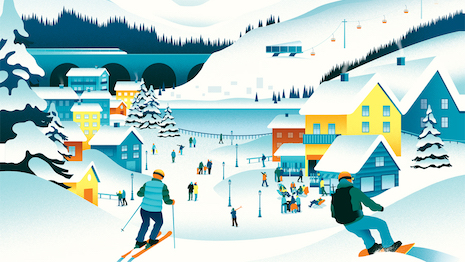The pandemic-induced Alpine mini boom is fortunately ending with a fizzle, rather than a bang, as limited supply keeps a floor under prices in most markets.
Per a new report from British real estate firm Knight Frank, across three key French resorts listings are down 56 percent, on average, compared to before the pandemic and this is set against a backdrop of strong demand. It is a similar story across St. Moritz, Verbier and Crans-Montana.
“Here, enquiries are strong, off-market sales are on the rise and buyers are having to prepare finance and paperwork in advance to be in a position to move quickly when a suitable property comes to the market,” said Kate Everett-Allen, London-based Knight Frank’s head of global residential research in the 15th edition of the Knight Frank Ski report.
“Lower price brackets are stymied by the higher interest rate environment, prompting owners to stay put rather than incur a hike in mortgage costs,” she said.
“Owners of higher-value homes are reluctant to surrender their Alpine home, given the limited alternatives and, for many, the lifestyle benefits of their mountain abode have never been more apparent.
“There are clear challenges ahead for ski resorts, not least climate change, the need to upgrade infrastructure and strict planning rules. But the market is evolving, attracting buyers from further afield – Asia and Middle East – and from southern Europe, as recent heatwaves prompt some second homeowners to pivot northwards.”
The appeal of a base in the French and Swiss Alps, however, goes beyond the lifestyle, Ms. Everett-Allen pointed out.
Prospective buyers cite the low purchase and ownership costs, opportunity for currency diversification and the potential for any rental income to provide a hedge against inflation in the current climate.
Knight Frank is a leading U.K. real estate firm.
High five
The research was pulled from Knight Frank’s second annual Alpine Homes Sentiment Survey representing the views of more than 320 of Knight Frank clients across 34 countries and territories.
Survey respondents include existing homeowners, prospective purchasers and those simply with a passion for the mountains. The Sentiment Survey was conducted between Sept. 1-17.
There were five key findings from the survey.
First, supply remains tight. Listings are down 56 percent, on average, across three key Alpine resorts compared to pre-pandemic levels
Next, prime prices continue to rise, averaging 4.4 percent annual growth across the 24 resorts tracked, with Swiss resorts on top this year.
Third, buyer motives are diverging. The split between clients targeting ski and year-round resorts is becoming more pronounced, putting different resorts in the spotlight.
Fourth, some 72 percent of buyers say the resilience of a ski resort influences where they buy.
Finally, with cash buyers accounting for 70 percent of Alpine purchases above $1.6 million, the impact of higher mortgage costs is limited to lower price brackets.
Moving further into the 2023-24 ski season, investors looking for worthwhile opportunities in the ski property market will take note of these trends.
“With supply remaining tight, prime prices continuing to rise and the split of purchaser incentives becoming more pronounced, savvy investors may find ample opportunities in year-round resorts,” the report stated.
Two Knight Frank experts outline the trends set to shape the Alpine property market in the report:
Here is the Q&A with Roddy Aris, Knight Frank’s representative for the French Alps.
What are the key trends that will shape the property market in the French Alps over the next five years?
Snow reliability for skiers and a resort’s offer in terms of infrastructure and activities for year-round usage will be paramount.
Resorts that fall short on either of these points will likely suffer in visitor and buyer numbers.
Which resorts do you see outperforming and why?
Chamonix and Megève are likely to outperform. These mid-altitude resorts set the benchmark for year-round appeal and have the added benefit of being within 75 minutes of Geneva Airport.
Val d’Isère’s recent strong performance is set to continue due to its excellent snow record, tight pool of properties and strong public and private investment.
Do you envisage more regulation – tax/planning/policy changes – in the coming years?
It is difficult to generalize planning modifications across the Alps. Each area has its own rules.
There is, however, a trend to limit the size of future construction as the pressure on space increases.
In Chamonix, for example, new builds are only permitted up to 200 square meters. Anything larger has to include additional social housing.
Our ski sentiment survey respondents are bullish on price growth over the next few years. Do you share their view?
In the last decade, the Alpine real estate market has evolved, moving from simply a ‘ski’ destination to a home-from-home market.
COVID was an accelerator and the drivers that put the market on this upward trajectory are still evident, meaning there is scope for further growth ahead.
Here is the Q&A with Alex Koch de Gooreynd, whose bailiwick is the Swiss Alps.
What are the key trends that will shape the property market in the Swiss Alps in the next five years?
I envisage we will see continued strong demand for primary residences in the French-speaking resorts.
In Graubünden, home to St. Moritz, Davos and Klosters, demand will be stronger for second homes.
Investment in infrastructure has become a priority, from improved accessibility and local amenities to international schooling.
Switzerland’s property rules and regulations create a premium for second homes. How much is this premium and do you envisage this two-tier market continuing?
With the number of second homes available to those without a Swiss permit shrinking, holiday homes in resorts such as Verbier and St. Moritz, can generate a premium of 20-25 percent.
To satisfy demand, authorities are allowing more hotel-style residences. Delivered with on-site facilities and concierge services, buyers must ensure they are rented out.
Which resorts do you see outperforming and why?
Resorts that boast genuine year-round village life will outperform.
Resorts such as Crans-Montana, Verbier, St. Moritz and Villars-sur-Ollon, which all boast strong resident numbers, will fare better than those that quieten down out of season.
Are Switzerland's safe-haven credentials still a factor for buyers?
Governments across advanced economies are raising taxes to plug big deficits and reduce the impact of rising debt.
Switzerland's low interest rate, its stable currency and attractive lumpsum form of taxation means it is firmly on the radar of UHNWIs.
Enquiries from the Nordics, Germany, France and Belgium have increased in 2023.
Please click or tap here to download the Knight Frank Ski Report 2024
{"ct":"6t\/b\/tg2QZpNTy\/QzHvLObUe4K9lgJnpo8YdNXvEdbvXpBsduW+mfbbWhZvNoOphVkXgqXcAI1yw8zaBp89\/pY8uHp1IKJPiBaYe4DFGEb9A259zl29GW1C6mCCRoDMDZfkkJJ7P1W8d8HKDiyS+GeUpaLTd6m8F8gWWHl4Cfrw9b0cFpJLFu8pJdnYXiiY6ixDpnH7T\/gQqbnQYtpjQPXvpJTGcB0Srm6txFNA5WjOSLm8rWGunjiYMA6Qblf8ND2YZJHywOT0UzZhC0m3\/3QLV3QAsN7BesybQLTcXhI4ZCVLR+yAWgo+P+nFe6TDyah49DM\/x3Hzj7zzYNeuLodRKuqToATHqVt1V1NoQjk8WfJNuhDtu3h09pgxX7JliAUktBnPgp8vuLD7jwLKGjWZh3T6ymGOB8Y8qK3FQ\/sdV3XcePmsLnJOnkuCxN5mtWIN9q99nTaOhtGLDtb8JDziwpP4xFafOvaDDROo7dXBRUyZsreLqBvLX9mG6iMF89nqIRTxUpXewW152UZ3TifPk5IryUj7FKWeYXFXzUw5wSbKPeCIHUL0y7EPqUjdN+wuU6gQWmL5vokDHSagDhZtigA6nRZuTBMHCPqIh4k8Ar0JEHbyhoQDI2q\/f4BBPFOyMNkGVhi9z6XWd20g2d5B+M2y07rGFBr\/oaF2puFAATVjfBWCJuWWjAfUz0uNWnJuLMkhReLuOCyKVcSZE9JG8Y4HTcHlu2WAwy0xAspG9eccsBho7kLKpCtORpozgZNMJ3\/XV4IE6NjYGneR3cvQgJwCuoeQv+ODixxmQ\/xm+78UCX6V0ptDTrRa7DAyGv4VPCBE9XWF1XFfA8csL5CLLEp414uTvz\/75G4J6I9Pu0FNk2ajZKPra8yl5gDsghl5hci6ZSV9DTY6NT8VvhOhkIPg+XU0G7rklNemzGzh7m0dy0qnjyLD+ki6ZpHQY18PvcyQZLI7+8pcUGvC62JgNOU1uLnpM0C1gKExv43BRLbqZVP++h6WGxgk3hY2nYZom4MD+5l7d\/C\/dsJmugkOAAFylnq2V8lCqJGu7ICaADXHzv+kUlVQ6qdPws+cA9QQqFjaypTU0H66oFJ2DQCXosA+mH4vVcX8XyScIBxXPzCm9Qe96ZbnLjAQlyPB7VbpU7od\/EH\/gp93vh9kwjZlFJRaOkDKaweGImMtsGBppU+GPxs5st0gCyJuiZS2yKlVJ9M6ygoKU40INCBDmqGjT5nRVJtll2zKCKxE0xnsps2VODWuOr5lo6krm5L3YruT1byc\/q505jujD6n4jrG89uw3SXPBf5DoHexTRck0dsyNKLDtP61hmgI6t9MairTdh4fcPPJedLWoceyFtAPC1DwsmsgSPH9kEV\/ResfRcjhIMfqZ5CRAq+ObGhYXCzKdirPaZpjGHLfwuYwTkxJ+mk1EvRgoiyAgvahTFYNvxGpGSg25HePpKj\/RbdiXH\/Du8qlmli6MLs8zQF38mAlP+Au7bPZq1ip6zoBvU9E+LV23cYXooUmnLUDE5a69veNbLHj24DK6MMHp\/aUkeoes\/g+JdD8t29m\/zKHAx4QiArTNRZT+wyzl1Yb+zGWLw1Lmw+Ju5kqyL530gUC72kR1XsLeAtcv95Rjir9K5SIExu004lMlBxU8XPLwmGgLmrSf1zE\/cY82gBckHOv55v3rHL6LizUCi2cKAX8waPYrwWi3rvog1NLWMm3jj\/hwuWdZFvTO+Sahnd21eyT3v7yCWGV5e7e8uQNVzOOTk4VoCb5+msoFvyg6k00CGsRLkWpbz\/d5iRToKuH1lnNj+onp6EpoFCCl4SoCCK\/oztgq4ytO1Vjqg0jNFXSw93T9t7wNVHFbEWVbSUy0TDIo8JBBM2eapFsqQZTrk1j7wHn1tUkEgxYFD4ALpDLvQFi9j\/hiR6p0x9GjuH0mrQ9O+0kNM\/ctrdNX2vcngjl9Ct1dW0mfRfhlRK5rsXwxcz6Swmz2zYyun8ymgAHmAedfmiGdIjxyY5aHUxyigdOo+X2cScbwwTAKdJvUEex+SeBDiuP4zVK5fsdLE52bk+y4dGRBuA26VeqNz\/Time187DOfaWtjsA7tQBg9ZAVi2vsk08fZYXFPVYMfpIpmHXMPjTYgLwCdlydHEg3hxJof5x95pLOFMcN+9JUy9FfAobyUz3ValF8FH2MCbU1tpCve7Vg9dGueT6484r0E8WsrAh7nzx9vZkRH\/Oz4F1f5Y9Qy2ZvVqpAasurhB2IBCnQ\/44INmIBjkySNSSnV4Zx3QoaqccSQkc+WmEFow6LMtsstOnuM7bWXu0\/Au4ljd0CEj2l\/Zdqe9UwWuGdXajEqG2lgTGWh81I11xEzol4Hd3dz8oAZ9brPGbZsCiCtHyt\/K1NCZ1I9RUCg8JEet121hSPAiqXIdc9E3K5aqcPSYcG0rHfw75l32BZLEqbsnTFIH4dAnaRFUiEuMWJm2pbqxC1DasbqQfDxyrKVrGaPh7+Lh+4q4HNlDbkxog+E+bltHbN0c6VTz13VaZKBCg+ZM7IIEff\/bEPtV3cOrC2mJ8+dQo8zWl+327JJArYQ7mQSdWgTeKW57SiNC4QNqkWCxUjLrvHy0yXukkuVTp4RCbSCEl8kIyTCTm2L+OXOsayRp8k3qaItwqwqm4v1m9sqGBizECnclnJWgCml\/TJTFD0vFqv6L6JcvNFoyxW54HgTinHlh9v\/aRb780rJny0DXGlDEH5wgJJpOFNLxIBv4yKozj2V7HeUOX99xFy1FrSOnThaT5rIH5mJKpiBf3oQ1Vqnkqb5i13g2hVrFHsPY4psQOhRtCugWsEyLW7XjgXB8k+6Xx56f3+KNdG8WSRJyHq8jyts2kagXinMyBO2OobCmPYOmQHSdpplIW2yyVyFmtUhxgGQqbXPOoJvZGqi0RFREFxwYmqO8xUJwjA8fjWtdrrnz56xlqrKG6sahgP4qt3njtGeTmAHxVudkDL+sZi72eomBi4p3GcjH4qT3EmjoQRmetvYVkQfsm16xPQjqtn7i8Vt96hTdFE3Ep\/GH14iwEWX45eP2BtEM1rb6iJbwGxeg\/SoZXuArTF4G+deS78Dtwg1HNrlHRRC3Efe3hZD\/oOTQisD0reg0bJvstezw4yRJ2haYhiDb\/bC88bPzZxi1fPBSWeAhlCKieFFZ5XDDKfN2L0hXQ68vD07OKoqeUdCevSxOZF+ipFEsKDQwkekJGN9sS3b4xnv\/jMaXflQ5+4cCXzHRBMYzn2vlTeyoMDdvZrFArPxojpHM1JfIB2WA7AOdrJEFSOguV5XLmg8KqD3kggsOGEaous2+NR6YbRbCXkBK5pRAwv44X6vIg361eQp5xj7x86dz3ntpLnGuNuZxCLtBOX26rL0H94C6opU5sY05MaI5twTQ4fBfyeEIy0sr+pTfR+mULftgH0BJ3zoVD5ee1hQPdezQpGJVGVPlW+NeWtgpao6rMp1f+3LwyxtX5jD8IFga77yJ6FGUwfhdAH+mdhKVDfQa2jMx8z08kX90h7OgxAYfI9HfUJSH1vB5ksVH4LbMECxXgRhXsuDAwBDWkPNmSoaslLbKh+9pVqZNb8cI+cSgLSjtQoiDfJMpk5UMUVq9AyRvggYgPURbYgnRIZvgzlBu0wAHgawNG\/FWVQO7x2kXl8vb+N6gQZXjfQieUbeVKDwcCdO22Bfdc\/rnoeYgINiUsKsDkBqD\/8p6PUHV8\/uFCivnyhJpOYWKYXVDdKn27M4W6spkYvFDpeMYctOl03SuZNOaBkuC1yD5N2iH8MgPghmU0s06w5tS7q471THSpPchESjp0\/nTV3Z9s0cWmXqBiP59Hz4FcXQIHCkEy2AJQ3XXNAjabd1PvG8bqm8u4noOmSZsZTKTyKa23rgGHpp\/JEBcwABbzj88Sjjfyh1c2LvEmbp23PsN+RFw8rbpBb2daLmaat6xCSTEpGHvk6wIO3NmYXmJ\/tQesYMG\/xTQpHGTnlC9DImqMPuCmnD+Bjlu15WMPYOcYBPv3Tr+LjF7bfd9Z0avaisZVkQOWJRYgq0eeKy2doOUYMURIm+8rkhfaD4DCPd0UmIFNwkKqsO+2JZuG87xfM9PF7JLI4gJwhhNCo6g0YdJtxMcz5vllyrKo0FLwSKOgu\/ZeXln+uMi3l5TT+mXvBtIvyYGDwkGpPRa3t0frTfpJMr0WZsZ93Kc\/wk9yRmwK4JN+CD+2sEJcAuQYqHd2MEqnPoLHZGYnjy3P4tgaTUX+30k6xPfEgX77GKONzLa9wmyX3HojTRXpzD\/KTpEVdRlG\/Rehd6uEexaWB5\/ZeDv8wX7BKaXYzR\/ZTuc7AjisRiUuEVtOQAjseFg62M6NT+uyBWIU\/v\/Wp7nUaHC2wtr\/E5yyoqbQIIo6dOSVcWW2KJ0O+eyUuKjiUsjdvjZncz1AiPgWh0r5ds88g97XojjeaEXjKuVr9F3VomNlELICOG91528O\/CGClLxnFqolkPAKAJCiLH\/WjFBZ4aZFEtZRUxCYjIqZvmw3aZwykm+qZzwgPAivNCwiXEVGwp7+aVs3iDYR2Hi6BtVKVWj\/esQTFZM5jddzDBeBadHIZl\/tXXkx0l9Hh97GW9NiuF1QdcrWrnh8PaYondWTtToqQGwXbZg8ZvEwOmF\/XzieBHGp8uhT7zqRStsgqOeXZAyRUjt6UG9Jk6QfEDGVhODiIGqwqILd9rgNZrYC9IsA9SIgT2Wl118nHM35Q4XTnWjLc2A97UwxEZ97QGS9MZ8AgsWcv43VqeyUugrUNDsAUnJf3+g9dLaktbVUjYI31CjCqWIPNLbL8UdrTyUy42LUj+DhKb2mFLTY5pFelXVcZb\/tJPsXQFt6Gc4gtvQnihGvqUmHzJrgaCKFdPXvqaB2bSxMUC2O+nXqOTfQSjBCyRe8nE\/8EnElDvnLRRf4cRXOHCofngF4SGdBBY1Levcwl\/OXsZ\/j\/scFOr2Df3ATrRr+R38oyQXgL87meEz4EyvtjhZoX4\/vqo+LKuj6gSMWa7j9uH5iUBzlfHGRd2RAGXFgRsuNcpicQ0nSYMWsEW+eNuTRCIFFmi7uFcVMV4eZnXu33rpRsCz2wsNkLtskCMXcmXPJCU9pOPTWij+42Jw\/ACq05nhtmTpNGWZyB+0YyA3CBcBfff2v+etLK9rofYs+dlzvQ9ECHx8PlnyPr\/7Gx45onrR\/i+CTJUmbDFfUXv1paxe\/9mxEfOKdsAicwceuTnJJj6OaLLW+Ldq6GTQOj0DbqQj1SQvhkqbTuQilp0Ruo2oq\/\/NwAGBIvFyx\/O309lBPDJ441S7UzJ0gXO6xguyuF1S7362ywGiNR+OGgqGyAK5teergJlU0S03q\/FryS6BjY1iQ2SZpHh2A5KKY6YZDRqCujw9+BN6vS4R2p6rfFG53dd1PZl6htDyEiE4wWWF+w+GAnFWp4ow\/GaV9OlR5cdfj7S\/RDKEGiA0ma9NdXuK3\/yvXehn8e2dovW3y3xsWD2poALea62FRMkrwLleL2ihi98bQveHOcCniFl9CHMsizR6Ly57OyPzrRCiql41kBm+Yz4vWxe9vGGR2\/BFB4B\/fl\/GDUskHOtXl3J7uwENN7wr5KtmSlRxUeYAr2v35XMvfKJMDxNSycKkgV1EdQGfomDtClghdugBf6ugpViSE\/DdHlPxxtLDDa71GSF7HNT4Xu7TsClinrKPlaILHiKG2MmjEwyGis8rdqWrVv8v3f0Vxy2coynvRFVCBHI59OrTCAoYnMmcPBHIMUPUff4wQCHoAbSYBVkbJHt5c0JmhFbDCZoK2s2GBWnNy0\/yXYli4UGBSxbY5RMondDa1vUPmTNhJHjYm6VbHp8fQBQmIhHZ3NIAnZqT1swvUhF5BnFASb3JAfiZWH+pOkGQrdFMeikMIKxF\/gI1zUcYrDtHeK\/H8HS89mYoWwIZcY7lnLKyXeYbTmncng00b4yt7\/hHM6wH4E0cobfEFuwKyFQMYcM2C\/dUqab3Nij0JyKY9oBHnI0oKkao0S3pg5UCr9ZY3jbwsy1HdW\/CdctEG2QBc7vh3JuTdfBL0n2ysHq\/j3YEHQAO3dT5O2t5OmWdXyb2r\/iB7qOftLUU5pDZmgEDh\/7PczbhjdUF+8w1UXPDRkmZLfwuQDUp1njPbeK3t56Sdg1REfc1SYCUcOD2Y0+I8dysjQOo1T+GvsKmKqJjJK0YAWpZsnrT41dM55Ky9n3RrlxoifG2ypHFtvBTwM7ZOfkOt6PRZQyiNba0WsT+k+Z9KZ41QKXEn21a3hcYQR7fc3YB\/dC+P73JI9yz6cbQNo+tfkdQF9moDErL1qSkbDY8mJi0o5ugltXDrzmj8we\/NbUtNgffHn8TALxg9+yjSc6s+ft1FfZpaz8afZ0psC8IcWyceObrY0xdxYlwUFCCjaNPwTIo\/IhbxKCwi1bYHn+CfwLPbYUKNMIKyZAQsnoL\/qewh41d0IkWErSID7LlxwpTVOMca5oSW05O0jlklg4uzcCu+JkosXnYSqFiR9c+IM4RhuSOz4F9H11KYYa44HOP2PNOscFI9INVAz4GqF+dZHynTbS2nQf\/ReHHz9ID4xU2R+0ymNAswA25nto1hlMAmq3+KO9ZUuiTYOHOmSJX4POsk0PBmrpTl9cadJh+syagwQkbSPCng6GlPVEGXmNTd7+\/8rmY\/AhGrwk3dnw7Vj8d37BMDJn4ooU+2jH1tYOSTBhGe5Vb06LstOBC3lExKYZP9d0uv6cStGk79PMRrWi+iB45QR0dSyMnW6E1rDisJQJNLprs6M7L8DP9YhP9R6QROcLsmFw\/Nxxq5begxDegp3MYW8xc\/8+EF3PLkL9oGeIIvBl4XZMj9cR2CBSRcSkcmF9z23FVAlIZJTm4wr66XIbekQip4KX8vFSc0az4yBaGTTLVrJgmmxMMHHyG0qvWNfhoqaMt3q2Zy\/p\/zMxhnoYhCTJ6lZ2cuOMkgTVIYRyn44y4rq3XBOpvXaJPxtm8lYZ5SPZiuu48UI3VIlHz\/pU43lu5P+40GttsqKTm3SSNZbY2v2O\/M+QUCLly3YMgH0d\/4VnD2dq9dvTdhNuWfTRZF\/GVrNizBz4K3oLpxVXTTMXa3p+5e06O6zcYUDeaeZyVFC18hKyw\/qibVu9NE0lJJ93UqAQ80p6rKm2pW5bxavu5BZwrH2m+K89OeV7A4qH1vl7ltcuilADr22sa73dKNEMNJ1Gw1EwNRKm6PgIXgP8sdLrzA814TwJmZfEplv80dlNkoUdflyiBEtYqcSRRm6A4r6ZqFYPXrjuBTBwqKbw6ser3JAd6wAPJouaHKdfH\/EW4zBTw4m5Nz55NHZWxbe5fWHjk51yGqgLxQ1RYkU8t15f6XkSPu0ClkakcLW47ogl9yikFDuzF8fF6P3h7G2pbTIFxr9hOY\/0q89xMpu2h0taJkZAdoyFjdQ9cnp5tyfbeDOlaDry9jUD9XrfwUyqw8+w3yGDI8\/GPY8Zr2YApEwdaz\/QdxMYzcTYoMyn2AkNIXmOENcF6Z+aPunzPIuUFGQ293F8LcQiZgFMiYA\/8Gh39HGwYQUqoXhjmCEAyR83WfyOOoNGAhXdJCs0NvTV3clww4tEPHYlRGw569B55v6kjWDX2gvk7Ci6DvZaDE+3pBe601Mz+n875JLS4PJtmCd4Dyihrh7ZBSmnsLFQNtPfNI0dt2rWN5S48wliE3Oap2EVbwXDslakqXfnuSANUz3C4LHAHvIchDX+N11YOHUmAf5yJetStNV+E1bx1q1Y+VmQOeByiJRGWBU7gpdlM0T2LFflhXpW4crw8cvg9km4MuI3vc3tgTFCvE7GoRLC9KEi3256FdaYLBEh9IdRUmna5mcUiyMyQvwcx5krAb7d4GrrKGBpH9sOW9qnFKFHWxuV6t3bebjPrNHU\/wR8wu+lafzxi5EKxrvjsWjkX2sKiv3eKgVzGLryPKc6kIr5jR+NrCV5JhyOApNIJXCvvsv4WcAuji5pEspAYps22L2hwyTbQZG2j+U77zQ+HnoSOm5ReQ0vtviztEdD949dlpcciuysq5cs9scHGAFca\/JajYksQQWrWfmHomcjcy\/72WgVST3VBWuK0FgiZQJiIW1C2R80dFUJi8fEPzqzE1oOpE+SDMaDyq6grMJzbSzxmG216qCujHnYD1hOZ\/zRX5LUOHNa6gupTBCpuw2bVr6SLCDLar0MpWTh0itKpQkdgogSUxKteZNSIqAi2rZ1owo1nuUCJtVez7wm1s8hF7FkS7XXGQqMQwX7TuCbxjsWCTeYRdgfrc\/KQzGrPfQbjufuyaWX2V4ucbxRDObz9Rc8f7zuf1iPSedBPNNNf+AlUKw70osy+lPdwuF7gtmLULKeKQqU1bbdmh\/O0RQOaT8XqJRT4OE+P4DsPbVq6UTK02Epj\/QRcHYSh05hUSu5vBUrOX79x2OC9j\/Lc8rD1Mj6AanT3RCdv8+eZZbeK5MilCZZ\/XiDu7YNQfDLud8ILI+Hm9H6nL1iDVfnvU\/L3XcYcjnBpJvBVbxCg2XZl4rG6zgOJHKQzBP+kUn5XHOxBqstextbYWwFOI8gVKccZUt2XgGQsMjc1d8NDiOFlB2BhyhJBOOK1IGZiYXDbnWU2Zxtjsp7wBdYKd+kphKyWdCKsq6sFWZ62YSC6FtYcUQuJDaqXHSOCMDKP8ikAymMOMzYXJ1hffrFviBy0NhJVvS39Usqgx+nWCw02MEJNPheQp1nEN9xTLVmXgAb1ds39rRC9S1pE8HF1oDPbgddUH9HbUGTcOcMEF5xvacyog2AvZi++ovEVEHJWdomgctKeX+ffW6O\/6RzPWd7RAvrcTsS9YKzEijFNMEg2aa3GjNAET1X9\/6mksbZMc0YJ9\/p7J9L0ZqfJYIN5aoh\/PC0u1tDM5FEkwuX2N8VOOH+mjOF0cLyQibquvBQ6hf5pGexOEr9F5Aarh9BHiiu7Swk\/zQEVcnQgan6McV06L9qeFNgKOOOAotO3R8Yqf0EZzIbcBcbFRa+NQx5OSUNiD\/iL8D3INGxt4kOVSh94bpAF2lHHKH+cY\/rtp1WNgLhCpa\/kwWMJbaKstLWHxVNi1DDW3azJS\/n6rDfojz1q4BXlZo9dHJp0qStZ0A5\/vYDsn0S36wY\/5hcT05o8GhWiRQQ8QlIcreeWEmRZvA1OqMIThKvCLEnozAaNITy0LvLELj3eKeOycAxyo06BL1jOF15au6+2mn2PVp0WNVkF5nPG7Y4TT9zNtdfZqRWm8uoASVi145Brx\/GARHzDfBbQvFc+RaFBF2hGgnCmGfbKerbWygh9CQXimAAh8FVALpXFbmXV72o\/snHR91by9n8tl1x5I6DHpTqGKkNwd\/Sa1los\/c7CvSBAGCdi3Wmnkfk+LKwU5XXGcYdZIQT5qYJz7MhiUpoQCNbAeMIIII8DhDlEyM9fwjZv2RxueULqgnAYqaRhQYU\/QtptNdddPEmCmItBLIYiEMSXGHVw+h+ipbvPFw5mpTDtWeZ3zQlTOuTpUGET6dhdQpbJEqahxb1+up7qGFKfb5wIf5UZyuOAQVHoq77CALFckIAYhZ6Ol7bDatgi8BRwuBGZVF2Uu9Mx7hJP0dHUSc\/bFyuT7p9AZgMX583XPX1jLJPF8sLZN+SMfM44HjNJecvt90QW9MkLTIPaxcAPD0TWz19k7yRdni3KnKQtLyAukyNKT98IrOyxe6z2e6H2FbvKHvz9CALMSNWE9RWe9j11gnmMFEoqOeR4EGVO1TxSKgb59OFlq6qYH6Wd7dTu3jrjkPMGmoN5vNMoPD5d43\/p\/\/ReNnXw7PQwcMM9x2gWMYX5WYP5mtv1dgDCynzsr+W8Zu70rMWlZTiML6019zpyAOq3f6iSJNm8P1CMYlmREdoMRmJ7Cl6OqgTQ+IKSjAjlm1dua8ecB8hdHbARQXkqca39y8UGtV5k\/K166vNgXGg\/W4+62NfCxyluB19ZwEYg9xhTo6mMneecatwoIgUlsP76NlOBhOlcF9Eojp5deYmw76EF7rb03ebmfYMyuht4eanv7Zu2h3VzBClpc5wY7RQhYj5r19LdFHgT2EV4OdjFcMj0CLxIhwekeIWmY8Kp42J6vlFm1z8uZChrRkmolyuiEfL7ibeInTyTWN6sp9h8QrcdZgg4b5o8gP\/Mi1FaHDecPNj74SGZB1A2WAh5eVdnnbzz+N3aKR0Z+2rvwHlMYo7XD6Du91gzu42HRpWDx+B7say6flwaodQ6DSPY2WhmcWtVEX51ZO014S6d1QQlqnlOaMeEQAwLJmfO334Bb6+L4JHkBdXlJb+lPeshMPqYjN4iIcjFxerOTqRv1+QN4ZEhHSXkXmjKD2cbL0Wl4JO1OhpcruWaUEdO+RT7rPIDFUIUEiHE4eOQzaQafkYLlAb9Xa1Wd34ju\/K2wbTygNd4Kqqg4ZVrbCGhBTNMf2ojFfkUDPAMB2kgSBcBVZyCcm53VErdWvSQ1u4zSOv6lWPxoNC1jtCmn90x+UzlR0FM9eHj9og6Am7WBWc2qONCfcGAFKJjq2dUoPc00I7xl7vx2nq8vt55PEXFLAED0kMBEdB+GOqZkTtBc51cjvxvs\/BVzpORrI56ha++D\/ZZ79e4K80dV2w0iUJsVBWfnzYcVJt9HUabt5n7CfOnJf2HapetWImjdFxm8weS471wF+TBwaVl9PhfuWLmhZVByXwI5L9UDvVAKzssdQMuJUNCkF0vZ3FQ+oUAihmnJRAUXGsN72a7WDcwfe441atd6xQFu7HNGYLHcO\/u4i4JYxQb6m8F0UZNo4KJHWFUfPvc8d6WuV6s3ilkRx+xNG3BPlBi1fU7sg==","iv":"2307ef317adb178d17344646cfc861b1","s":"a4d1a3ce76ec2a3e"}


























